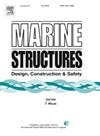Characterization of fatigue crack growth behavior in welded tubular T-joint
Abstract
This paper focuses on investigating the fatigue crack growth (FCG) characteristics and residual fatigue life of tubular T-joints which are prone to suffer fatigue damage at the brace and chord intersections under multi-axial stress. Static and fatigue loading tests are performed to investigate the FCG behaviors of tubular T-joints, combining beach marking technique. The evolution of FCG characteristics is studied during the crack growth, convergence and wall penetration through an efficient co-simulation system that established using the multi-scale modeling technique. Fracture morphology analysis is conducted to gain insight into the FCG behaviors combining the scanning electron microscope (SEM) observation. Results indicate that multiple cracks initiate at the crown regions and subsequently evolve circumferentially around the weldments in a doubly-curved shape towards wall-thickness. Interaction effects between adjacent cracks extend the fatigue life along the outer surface, attributed to the premature exposure of converged crack front and the induced variation of stress intensify factor (SIF) distribution along the crack front. The dominant failure mode of tubular T-joints is characterized by an opening mode crack, with the contribution of anti-plane shear mode crack gradually increasing as structural symmetry diminishes. The established co-simulation system shows advantage in capturing the FCG behavior, predicting the fatigue life and characterizing the FCG characteristics with a good balancing of simulation efficiency and calculation accuracy.


 求助内容:
求助内容: 应助结果提醒方式:
应助结果提醒方式:


